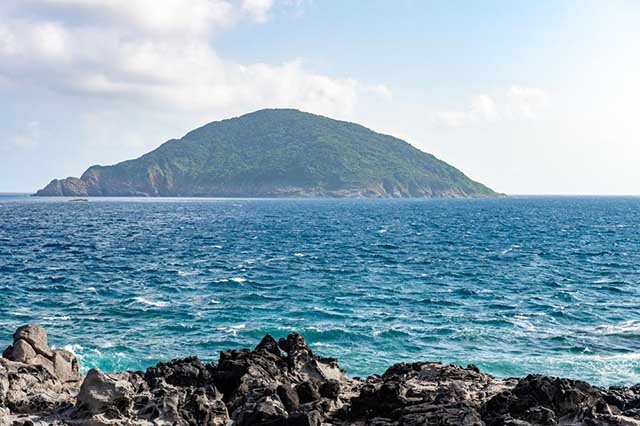
The Goto Islands, a string of unpolished gems in the East China Sea, became the final waystation for official envoys to Sui China and its replacement, the wealthy, cosmopolitan Tang Empire based in the mighty capital of Chang’an (now Xi’an); and Kukai himself, the great transmitter of Shingon Buddhism from China to Japan, spent time on the islands, steeling himself for the trip west. The history of those trips and the cultural and religious treasures remain alive on the islands today.
-
![Memorial statue of Kukai (a.k.a Kobo Daishi)]()
Memorial statue of Kukai (a.k.a Kobo Daishi)
Whether Kukai ever really stood in this spot on the northwest tip of Fukue Island, or if his statue is simply the project of eager township bureaucrats hoping to revitalize tourism in a town where the fisheries are no longer paying the bills, well, it’s hard to know for sure. It’s a fine invitation, though, to look out at the South China Sea from Kukai’s eyes. Ah, to look out from Kashiwazaki Cape sometime in the 9th century, dreaming of the glories of the Tang Empire! It was from the Tang capital at Chang’an that modernity flowed: the poetry of Li Bai, the otherworldly ash glazed scallion green pottery, clay figurines depicting life at the far reaches of the Silk Road, music, woodblock prints, the sutras of Subcontinental sages… Looking west, it was—and still is—almost a straight shot to the port at Yangzhou, the gateway to the culturally fertile Jiangnan region and a short trip to the Grand Canal and the Yangtze River.
![]()
Kukai returned to the Goto Islands a fully-initiated master of esoteric Buddhism. The religion had been present in Japan for centuries before Kukai’s return, but he would forever change the way many practiced its teachings. Myojoin Temple was simply the private chapel of the ruling family of Fukue Island, until Kukai visited it in 806, on his way back to Honshu. The temple is named for the bright star that Kukai witnessed hovering in the dawn grey while deep in prayer.
![]()
- Myojoin Temple
-
-
- Nagasaki Goto-shi Yoshidacho 1905
-
-
-
- 0959722218
-
-
-
- [Morning] 9:00-12:00 [After…
-
View AllMyojoin’s pattern of expansion, destruction, and rebuilding is the same as nearly every other temple in the country, but it’s somewhat remote location on Fukue Island mean that it is well-preserved and peaceful. Apart from the allure of treading in the footsteps of Kukai and its setting in the idyllic hilly scrubland of the island, the ceiling of the main hall is decorated with bird-and-flower paintings inspired by the work of Tang masters like Huang Quan.
![]()
Out on the northwestern tip of Fukue, Miiraku is a good launchpad for visits to the beaches at Takahama or Shiraragahama and historical sights like the Catholic Tombstones of Fuchinomoto. Now part of Goto City which administrates the bulk of populated territory on the islands, Miiraku was once a bustling fishing port. Miiraku is another of the many spots on the Goto Islands where daydreams of an earlier age are always lurking. History was made in Miiraku: even before Kukai’s trip west to China, this was one of the last stops of the kentoshi mission’s ships, before they headed out (straight across to Yangzhou or north to follow the Korean peninsula or south toward the Ryukyus). The glory days are long behind this fishing village but it’s worth stopping by on the way to other sites.
![]()
The wilder stretches of shoreline at Shiraragahama and Gyougasaki are truly stunning. The parks at both locations have plenty of modern amenities, including a replica kentoshi ship at Shiraragahama, but, from the right vantage point, it’s impossible not to find oneself floating backwards through the centuries.
![]()
- Shiragahama Beach
-
-
- Nagasaki Goto-shi Miirakumachi Hamanokuri
-
View All
In a country with a history as carefully protected and curated as Japan’s, there can be a sense of alienation from the past, a disconnection from the pristine temples and rebuilt castles… Perhaps it is easiest in the absence of any markers of the passage of time or outward evidence of historical events, to place oneself in days gone by. Knowing something of the history of the islands’ coasts, it is easy to imagine the anxiety of a sailor taking his last view of his own nation before venturing out on the treacherous crossing to Yangzhou, or the relief of Kukai when he first glimpsed these beaches after safely returning, a changed man, from his studies at Qinglong Monastery in Chang’an.




 Go here
Go here








